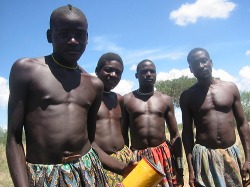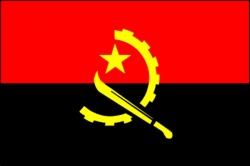ANGOLA: INDIGENOUS ETHNIC GROUPS
http://org.newtrier.k12.il.us/academics/faculty/hjelmgren/africa09proj3lev.html
Title.

Angola has been an independent country from Portugal since November 11, 1975, but the area has been inhabited by many different ethnic groups since before that time. What is it that designates what, or who, these ethnic tribes are? To answer this question it is vital to first answer this: what is ethnicity? Ethnicity is a common identity among a group of people. It has been said by Thomas Collelo, “Although common language and culture do not automatically make a common identity, they provide a framework within which such an identity can be forged, given other historical experience. Insofar as common culture implies a set of common perceptions of the way the world works, it permits individuals and groups sharing it to communicate more easily with one another than with those who lack that culture” (Thomas Collelo) With this understanding it is safe to say that even though there are many different ethnic groups in Angola, the three most prominent are Ovimbundu, Mbundu, and the Bakongo. All three groups had had struggles over the years but are still strong today.
The Ovimbundu tribe makes up 37% of the population and is mainly located in the west-central part of Angola. Ovimbundu generated itself “Like most African groups of any size, the Ovimbundu were formed by the mixture of groups of diverse origin (and varying size). Little is known of developments before the seventeenth century, but there is some evidence of additions to the people who occupied the Benguela Plateau at that time. Over time, a number of political entities, usually referred to as kingdoms, were formed. By the eighteenth century, there were twenty-two kingdoms. Thirteen were fully independent; the other nine were largely autonomous but owed tribute to one of the more powerful entities, usually the kingdom of Bailundu, but in some cases Wambu or Ciyaka. By the beginning of the second decade of the twentieth century, effective occupation by the Portuguese had caused a fairly rapid decline in the power of the heads of these kingdoms, but Ovimbundu continued to think of themselves as members of one or another of the groups based on these political units after World War II.” (Thomas Collelo) Since then they have continued to grow even when still under Portugal control. The Ovimbundu tribe gain many profits from trade set up with Europeans. They traded slaves, ivory, and beeswax. Slaves where the largest export though so “With the decline of the slave trade in the last decades of the nineteenth century, the entrepreneurs among the Ovimbundu turned to the rubber trade, abandoning the warfare and raiding that had hitherto been integrally related to their economic activities. The rubber slump at the beginning of the twentieth century, the end of the de facto autonomy of their kingdoms not long after, and the displacement of Ovimbundu traders by the Portuguese forced these people to turn to cash-crop agriculture” (Thomas, Collelo). Now, this largely agriculturally based community is now financially aided by many North American Christian missionaries that have established many villages with their own churches, schools, and clinics. Because of this they have been able to maintain the Ovimbundu culture.
The Mbundu tribe has also been around for quite sometime. It is located just north of the Ovimbundu and is the second largest ethnic tribe at about 22% of the country’s population. The Mbundu culture is strongly influenced by the Portuguese much like the Ovimbundu. “By the late 1960s, the Mbundu living in the cities, such as Luanda and Malanje, had adopted attributes of Portuguese lifestyle. Many had intermarried with Portuguese, which led to the creation of an entirely new class of mestiços. Those who received formal education and fully adopted Portuguese customs became assimilados.” The Mbundu were also active slave traders for many centuries and had also fallen into forced labor by the Portuguese.
The Bakongo tribe makes up 13-15% of the population and is the third largest ethnic group. They had very different experiences then the Ovimbundu or the Mbundu during the colonial period. They had the most constant and best relationship with the Portuguese because they lived near the coast and were fairly unaffected by the coffee economy, with greatly affected the Ovimbundu tribe as well. “One of the first major revolts of the nationalist struggle was instigated by Bakongo in March 1961 in the northwest. The Portuguese crushed the peasant attack, organized by the Bakongo group, the Union of Angolan Peoples (União das Populações de Angola -- UPA), on their settlements, farms, and administrative outposts. Subsequently, 400,000 Bakongo fled into Zaire. In 1962 the UPA formed the National Front for the Liberation of Angola (Frente Nacional de Libertação de Angola -- FNLA), which became one of the three major nationalist groups (the other two being the MPLA and UNITA) involved in the long and bloody war of independence. Most of the FNLA's traditional Bakongo constituency fled into exile in Zaire during the war. Following independence, however, many Bakongo exiles returned to their traditional homesteads in Angola. They had since retained their ethnolinguistic integrity.” (Thomas Collelo). The Bakongo tribes as well as the others are strong in their deep routed culture tracing back to the 16th century.
Even though not all of them were involved in this same trade or economic situations they all have rather similar past. It is extremely important for us to read about and understand the past and futures of these groups in order to understand our cultures and communities.

